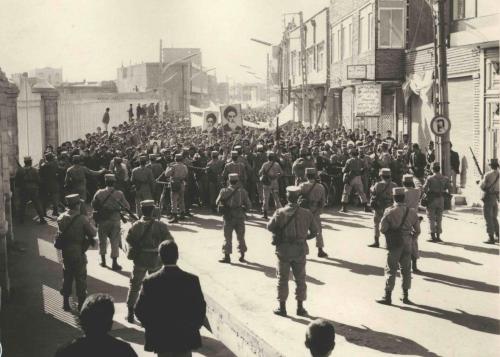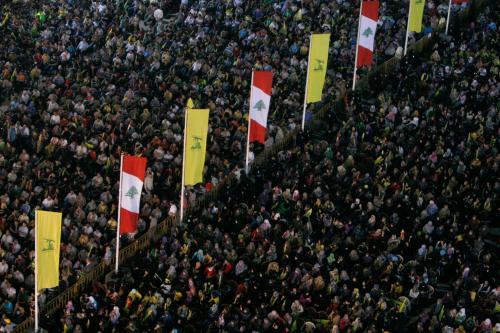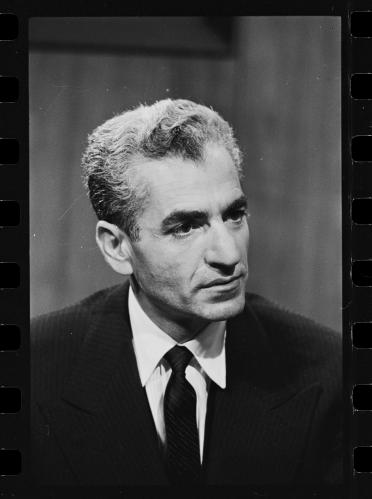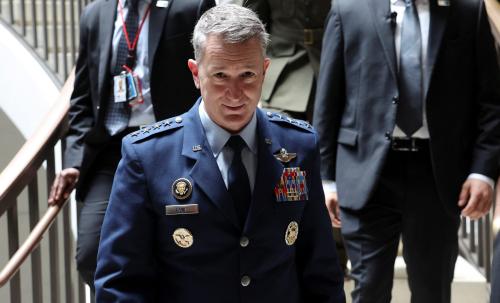Four decades have now passed since a mass political movement espousing the triumph of sacral authority over secular toppled Iran’s absolute monarch, Mohammad Reza Pahlavi, and his seemingly impregnable state. Just as definitively, the revolution that abrogated the Pahlavi dynasty in 1979 scuttled a set of assumptions about religion, modernity, and political development that were previously considered axiomatic.
Widely considered unthinkable even as it was unfolding, the ouster of the shah and the assumption of authority by an inchoate coalition of leftists, liberals, and Muslim clerics captivated the world. The subsequent establishment of an Islamic Republic in Iran dramatically transformed the nation’s internal politics, economy, and society and its impact echoed well beyond its borders to reconfigure the regional landscape, the geostrategic balance in the Middle East.
For Washington, the revolution represented a devastating strategic loss. Since the British withdrawal from the Persian Gulf in 1971, Iran had become the cornerstone of America’s security architecture for protecting Western interests across the region. As both the “pivot in the price hike” and the sole regional leader willing to buck the Arab oil embargo, the shah had made himself equally consequential for energy markets and the global economy. Iran’s revolution reshaped the country, the region, and its interaction with the rest of the world, especially the United States. Forty years later, the legacy of the revolution lives on in both Washington and Tehran in the mutual antagonisms it brought to the fore.
An auspicious beginning
The United States and Iran were not old allies, but Americans had played a crucial—and until 1953, constructive—role in each of the formative experiences in the birth of modern Iran. An American teacher died in the fight to advance rule of law during Iran’s 1905 Constitutional Revolution. American missionaries established dozens of hospitals and schools around the country, training a generation of future leaders and helping expand female education. In the final years of the Qajar dynasty and the early years of the Pahlavi reign, U.S. officials were seconded to help to strengthen the state’s fiscal management, advance administrative reforms, and reorganize its gendarmerie. Washington advocated on behalf of Iran, then occupied by the Allied powers, during the Paris Peace Talks after World War I, and again after the second, when Russian troops helped instigate secessionist movements in northern Iran and refused to withdraw as agreed.
 This propitious start to the relationship, which positioned Washington more favorably than the imperial machinations of Britain and Russia, is all but forgotten today, thanks to the U.S. role in ousting Iran’s nationalist prime minister in 1953 and the subsequent embrace of Shah Mohammad Reza by successive American administrations. The coup was a momentous turning point for Iran; coinciding with a broader imperative around American engagement in the Middle East, the CIA’s role in preserving the monarchy meant that for the first time, Washington assumed a real stake in Iran’s fate. The generous American program of technical and financial assistance that followed the shah’s reinstatement enabled him to impose greater central control and reassemble the instruments of the state under his personal authority. Over time, it would become painfully clear that the costs of the coup in stoking paranoia, enabling repression, and undermining the Pahlavis’ legitimacy vastly outweighed its short-term benefits, but at the time the preoccupation with the Cold War obscured Iranian resentment fueled by the American intervention.
This propitious start to the relationship, which positioned Washington more favorably than the imperial machinations of Britain and Russia, is all but forgotten today, thanks to the U.S. role in ousting Iran’s nationalist prime minister in 1953 and the subsequent embrace of Shah Mohammad Reza by successive American administrations. The coup was a momentous turning point for Iran; coinciding with a broader imperative around American engagement in the Middle East, the CIA’s role in preserving the monarchy meant that for the first time, Washington assumed a real stake in Iran’s fate. The generous American program of technical and financial assistance that followed the shah’s reinstatement enabled him to impose greater central control and reassemble the instruments of the state under his personal authority. Over time, it would become painfully clear that the costs of the coup in stoking paranoia, enabling repression, and undermining the Pahlavis’ legitimacy vastly outweighed its short-term benefits, but at the time the preoccupation with the Cold War obscured Iranian resentment fueled by the American intervention.
Instead, Americans and the world marveled as Iran made epic progress over the next quarter-century. Under the auspices of the shah’s “White Revolution,” a multifaceted set of political and economic reforms that, together with the oil boom, helped generate rapid growth and a dynamic, cosmopolitan society. Average annual growth rates between 1959 and 1972 were 9.8 percent—on par with the more recent experience of China. The number of primary school students increased from 286,000 to 5.2 million, and adult literacy rates shot from 16 percent to 36 percent in the monarchy’s final 15 years. Women secured the right to vote and run in parliamentary elections, and their political participation helped advance a progressive new family law. Iran’s middle class approached one-fourth of the labor force, composed of an estimated 700,000 salaried professionals and an additional 1 million families associated with the bazaar and small manufacturers. For millions of Iranians, the shah’s development program generated tangible improvements in their quality of life and expectations of upward mobility for their children.
And yet Iran’s aggressive modernization triggered deep fissures that, over time, escalated to corrode the foundations of the monarchy. The launch of the shah’s reform agenda met with fierce opposition among influential constituencies in the clergy, the merchant class, and major landholders. They saw land reform as an encroachment on their income, the extension of women’s suffrage as an assault on their values, the legal protections afforded to Americans in Iran as an intolerable capitulation of Iran’s sovereignty. In 1963, Ayatollah Ruhollah Khomeini emerged as the most powerful voice of opposition, denouncing the shah as a “wretched, miserable man” and a puppet of American and Israeli masters. His arrest and deportation to Iraq a year later seemed to neutralize the threat; as would eventually become clear, Khomeini’s arms-length distance from the shah’s steady attenuation of Iran’s political opposition only magnified his influence.
Iran’s thirst for “modernity”
Through the 1960s and 1970s, the embrace between the shah and Washington grew ever closer. With commercial ties expanding steadily, Iran’s great leap forward had direct beneficiaries in the United States. The floodgates opened—especially for military hardware—after the price of oil quadrupled in 1973. The shah launched a big-budget defense buildup, purchasing more than $16 billion in arms from the United States between 1972 and 1977, on top of approximately $3 billion per year in bilateral civilian trade.
The bilateral relationship transcended the obvious energy and military trade. Between 1973 and 1978, telephone calls between the United States and Iran skyrocketed by 1,600 percent. At least 60 thousand Iranians lived or studied in the United States, while 50,000 Americans were working in Iran. More than 50 American universities had campuses in Iran or partnerships with Iranian counterparts. Tehran, Isfahan, and Shiraz became chic destinations for tourists: Andy Warhol went there to paint the empress’s portrait; Elizabeth Taylor visited, drinking vodka with her caviar. And the shah invited his son’s favorite actor, the star of the 1970s television hit “The Six Million Dollar Man,” who brought his starlet wife, Farrah Fawcett. “This is an enchanted land in which modernity, thanks to an enlightened young ruler and the presence of an enormous supply of petroleum, harmonizes with one of the earliest civilizations known to recorded history,” gushed the New York Times in 1965. The Pahlavis’ Iran was distant but familiar for Americans—and firmly on the path to “modernity.”
The shah thought so as well. He abhorred traditionalism; as he declared in his memoirs, “I could not stop building supermarkets. I wanted a modern country.” Giddy with success and eager to expedite Iran’s transformation, he boasted that Iran’s economy would outpace that of Germany and France by the turn of the century, overriding his advisors’ objections and doubling government spending in 1973. But even with record oil revenues, the scope and pace of his ambitions outstripped the country’s absorptive capacity. Iran suffered all the predictable consequences of hyper-growth: rising inflation, corruption, and income inequality; rapid urbanization and inadequate public services; structural bottlenecks, vast inefficiencies, and an influx of foreign workers and associated cultural frictions. As Tehran sought to manage the disruptive impact of volatile energy markets, its remedies often exacerbated the problems, especially given the shah’s increasingly autocratic political impulses. Since 1953, he had taken care to eliminate any potential threats to his reign, through the much-feared secret police and restrictions on political activity. Soon enough, the monarchy found itself facing a steadily escalating barrage of protests, as an improbable cooperation among Iran’s traditional nationalists, radical Marxists, and a highly politicized faction of the clerical establishment came together to confront the shah.
Shock wave
The revolution took Washington by surprise, though it should not have. The rumblings of trouble in Iran had been evident for years: in the attacks on Americans in Iran by radical groups; the burst of intellectual activism in moments of openness; the protestors who besieged the Pahlavis (and the White House on one occasion) on multiple U.S. visits; and a hundred other indicators of political alienation and economic dislocation. Still, the rapidity of the monarchy’s collapse was breathtaking. Only a year before the shah prepared for his final, ignominious flight from Tehran, he was lauded by President Jimmy Carter in a New Year’s Eve toast that described Iran as “an island of stability in a turbulent corner of the world.”
The phrase remains a kind of shorthand for American failure to anticipate developments in Iran and the broader Middle East. However, it was not only Americans who misread the monarchy’s vulnerabilities. The “island of stability” catchphrase was borrowed from remarks made by then-Prime Minister Amir Abbas Hoveyda on a 1968 visit to Washington. Detained by the shah in November 1978 in a bid to assuage rising public fury, Hoveyda was executed in the post-revolutionary purges, the highest-ranking of the shah’s officials to lose his life in the transition. The tsunami of political change that overtook Iran in 1978 took Iranians by surprise as well, including some of the leading voices in the opposition.
The upheaval in Iran compounded a sense of disarray and futility surrounding America’s role in the world.
For many in the United States, where scenes of the mass demonstrations played on the nightly news, the upheaval in Iran compounded a sense of disarray and futility surrounding America’s role in the world that remained potent in the aftermath of the Vietnam War. “America cannot do a damned thing,” Khomeini liked to say, and the early aftermath of the monarchy’s demise offered ample evidence. Days after Khomeini returned to Iran and the last vestiges of the shah’s government fell, Iranian demonstrators briefly attacked the U.S. embassy in Tehran. “We used to run this country,” an American diplomat commented bitterly in February 1979 as he prepared to leave Iran. “Now we don’t even run our own embassy.”
These words would prove horribly prescient. Only a few days earlier, Iranian demonstrators had briefly attacked the U.S. embassy in Tehran. Iran’s provisional foreign minister defused the crisis, but over the next nine months, the balance of power within Iran’s still evolving new order had shifted in favor of the radical Islamists. In November 1979, the embassy was overrun by student protestors yet again, and this time they secured Khomeini’s blessing. Their seizure of the embassy staff launched a hostage crisis that became a 444-day national ordeal, dooming Carter’s re-election prospects and forever altering the way that Americans engage with the Middle East. Khomeini described the embassy takeover as “Iran’s second revolution,” since it handily sidelined more moderate forces in the government and expedited the consolidation of clerical rule. It also precipitated a full-blown breach with Washington, which had sought to build relations with the post-revolutionary leadership.
“Who lost Iran?”
Iran’s abrupt transformation from a reliable U.S. security partner and hub for American investment to a seethingly anti-American regime led by an ascetic cleric confounded Washington. “How could Iran, with its oil and its strategic situation between the Soviet Union and the Persian Gulf, between Europe and the Middle East, fall under the sway of a holy man out of the mists of the 13th century?” a New York Times columnist beseeched in March 1979. “How could the shah, a monarch who commanded more tanks than the British Army, more helicopters than the United States First Cavalry in Vietnam, be pressured so neatly out of power?”
The highly charged battle cry of “who lost Iran?” echoed through the American establishment in the aftermath of 1979. Some blamed the State Department, which had few Persian speakers stationed in Tehran prior to the revolution and discouraged U.S. diplomats from engaging with opponents of the shah. Others blamed the intelligence community, which infamously reported to Carter in August 1978 that “Iran is not in a revolutionary or even a ‘pre-revolutionary’ situation.” Some blamed Carter, who repeatedly gave public reassurances that the monarchy would stand but failed to provide clear and effective guidance to the shah as he clearly lost the capability to manage the situation. Within Iran, conspiracy theories abounded, continuing to this day, many suspecting it was all somehow a British plot. For his part, the shah died convinced that his success in wresting control of Iran’s oil sector away from the international oil companies had precipitated a scheme to unseat him.
None of these narratives are entirely accurate. American intelligence, diplomacy, and leadership each exhibited shortcomings, but as a study published in the CIA’s in-house journal acknowledged, insufficient information did not cause the fiasco of U.S. policy toward Tehran in 1978-79. In fact, the study notes, “the US compiled a substantial amount of accurate information and analysis about major events, particularly the demonstrations and riots.” And recently declassified information has documented the Carter administration’s efforts to broker a peaceful transition directly with Khomeini after the shah had left.
Where Washington failed on Iran and with other black swan developments arose from a failure of political imagination, to borrow a phrase from my colleague Bruce Riedel. The presumption of the shah’s durability was so deeply engrained that alternative trajectories seemed inconceivable, especially the unprecedented prospect of a religious caste taking control. No one in Washington was prepared to indulge in “thinking the unthinkable,” as the last U.S. ambassador to Tehran described the prospect of the shah’s overthrow, until it was essentially too late to alter the course of history. And ultimately, as Carter himself acknowledged repeatedly in the aftermath, “Iran was not ours to lose in the first place. We don’t own Iran, and we have never had any intention nor ability to control the internal affairs of Iran.”
No one in Washington was prepared to indulge in “thinking the unthinkable.”
Two countries, intertwined
The Iranian revolution left a broad and complex legacy within Washington. It remains one of the seminal examples of a “black swan” national security crisis with catastrophic impact on American domestic politics as well as foreign policy. Today, the consequences of the revolution continue to shape the bilateral dynamic between Washington and Tehran, even as memories of the moment itself begin to fade in both countries. The events of 1978-79 and the political system that it wrought have placed Iran squarely at the heart of U.S. security challenges for the past 40 years and will continue to do so well into the foreseeable future.
That revolution enshrined the world’s first and only modern Muslim theocracy, and the violence that erupted in its wake situated Iran as the epicenter of a wave of religiously-inspired activism and virulent anti-Americanism that would eventually radiate through the region and elsewhere. As Christopher Hitchens remarked with only minor exaggeration, Iran’s transformation in 1979 “moved us from the age of the Red Menace to epoch of Holy War.”
By grounding its identity and legitimacy in anti-Americanism, Tehran remains just as firmly contingent upon the United States as the shah ever was.
By transforming the nature and locus of the threats to regional stability, Iran’s revolution also drew Washington into the Middle East in increasingly thorny ways. Instead of merely seeking to deter Soviet influence, the United States was now forced to contend an implacably hostile power in a strategically vital region that was ready and able to wreak havoc on American interests and allies. No longer was offshore balancing via regional partners a sufficient posture for U.S. presidents from either party; increasingly, Washington found itself drawn into much more substantial direct military engagement in the Middle East. Our track record in this endeavor has proven incredibly costly in both human and financial terms.
For their part, Iran’s revolutionaries remain mired in the mess they created in 1979: a state whose ideological impulses cannot be fully overcome, even when they subvert its obvious interests. The founders of the Islamic Republic were determined to extricate their government from what they perceived as Washington’s control. However, by grounding its identity and legitimacy in anti-Americanism, Tehran remains just as firmly contingent upon the United States as the shah ever was. The regime’s pointless, destructive rivalry with Washington distorts any objective pursuit of Iran’s real interests in a stable, prosperous region, and leaves its people vulnerable to the long reach of U.S. economic and military might. “Obviously this can’t go on forever,” an Iranian political scientist commented to a Western reporter in March 1979. And yet forty years later, the revolutionary state remains firmly in place and the bilateral estrangement is as fierce as ever.
In subsequent pieces, I’ll examine how the establishment of the Islamic Republic has shaped its evolution over the past 40 years, and consider the prospects for its future at a time of renewed uncertainty.
The Brookings Institution is committed to quality, independence, and impact.
We are supported by a diverse array of funders. In line with our values and policies, each Brookings publication represents the sole views of its author(s).







Commentary
Op-ed1979: Iran and America
January 24, 2019